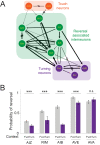Inhibitory feedback from the motor circuit gates mechanosensory processing in Caenorhabditis elegans
- PMID: 37733772
- PMCID: PMC10617738
- DOI: 10.1371/journal.pbio.3002280
Inhibitory feedback from the motor circuit gates mechanosensory processing in Caenorhabditis elegans
Abstract
Animals must integrate sensory cues with their current behavioral context to generate a suitable response. How this integration occurs is poorly understood. Previously, we developed high-throughput methods to probe neural activity in populations of Caenorhabditis elegans and discovered that the animal's mechanosensory processing is rapidly modulated by the animal's locomotion. Specifically, we found that when the worm turns it suppresses its mechanosensory-evoked reversal response. Here, we report that C. elegans use inhibitory feedback from turning-associated neurons to provide this rapid modulation of mechanosensory processing. By performing high-throughput optogenetic perturbations triggered on behavior, we show that turning-associated neurons SAA, RIV, and/or SMB suppress mechanosensory-evoked reversals during turns. We find that activation of the gentle-touch mechanosensory neurons or of any of the interneurons AIZ, RIM, AIB, and AVE during a turn is less likely to evoke a reversal than activation during forward movement. Inhibiting neurons SAA, RIV, and SMB during a turn restores the likelihood with which mechanosensory activation evokes reversals. Separately, activation of premotor interneuron AVA evokes reversals regardless of whether the animal is turning or moving forward. We therefore propose that inhibitory signals from SAA, RIV, and/or SMB gate mechanosensory signals upstream of neuron AVA. We conclude that C. elegans rely on inhibitory feedback from the motor circuit to modulate its response to sensory stimuli on fast timescales. This need for motor signals in sensory processing may explain the ubiquity in many organisms of motor-related neural activity patterns seen across the brain, including in sensory processing areas.
Copyright: © 2023 Kumar et al. This is an open access article distributed under the terms of the Creative Commons Attribution License, which permits unrestricted use, distribution, and reproduction in any medium, provided the original author and source are credited.
Conflict of interest statement
The authors have declared that no competing interests exist.
Figures





Update of
-
A high-throughput method to deliver targeted optogenetic stimulation to moving C. elegans populations.PLoS Biol. 2022 Jan 28;20(1):e3001524. doi: 10.1371/journal.pbio.3001524. eCollection 2022 Jan. PLoS Biol. 2022. Update in: PLoS Biol. 2023 Sep 21;21(9):e3002280. doi: 10.1371/journal.pbio.3002280. PMID: 35089912 Free PMC article. Updated.
References
MeSH terms
Grants and funding
LinkOut - more resources
Full Text Sources
Research Materials

